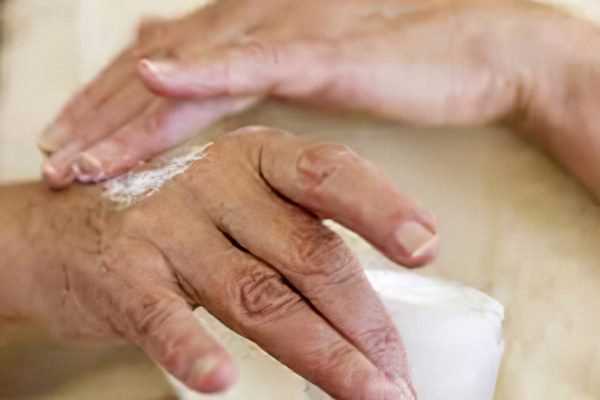Contents

Allergic dermatitis in adults and children requires careful attention and competent treatment. Usually people do not pay attention to mild manifestations of dermatitis.
However, this is not just a small cosmetic defect, but a pathological process that affects many body systems (including the immune system). That is why it is so important to know the main thing about allergic dermatitis.
Description of the disease
Allergic dermatitis equally often affects people from different countries with dissimilar climatic conditions and different traditions. This is a non-contagious disease, manifested by an inflammatory reaction on the skin in response to the impact of a particular irritating factor. Redness, peeling, swelling – it is simply impossible not to notice it. And aesthetic imperfection is the smallest trouble that the disease carries. Intolerable itching, burning and other painful sensations significantly reduce the patient’s quality of life.
In recent years, humanity is moving away from nature, around us there are many substances and materials that can “start” pathological processes in the body. It is almost impossible to avoid contact with them. Therefore, an increasing number of people around the world are faced with allergic dermatitis. Weakened immunity, hereditary predisposition, unhealthy lifestyle (especially poor nutrition) – all this greatly increases the chances of suffering from the disease.
Often people take the manifestations of allergic dermatitis lightly. However, it is possible that the disease will progress, each time causing more and more inconvenience. In especially severe cases, inpatient treatment is indicated.
Symptoms of allergic dermatitis
The degree and form of manifestations of allergic dermatitis depends on many factors:
age of the patient (as a rule, the younger the patient, the more pronounced the symptoms);
duration of exposure to the allergen;
general health and immunity characteristics of the patient.
Finally, the type of allergic dermatitis is also important.
Allergic phytodermatitis, the “culprits” of which are sensitizers contained in the pollen and juice of some fruits and plants, has the following symptoms:
burning and itching of the skin (usually on the hands);
redness of the skin (erythema);
eruptions in the form of bubbles.
Contact dermatitis declares itself upon repeated contact with the irritant-allergen and, accordingly, completely self-destructs shortly after the termination of this contact. Its symptoms are:
clear boundaries of the reddened area of the skin, repeating, as a rule, the forms of the allergen in contact with the body;
severe swelling of the affected skin area;
rash in the form of small vesicles filled with liquid;
erosion at the site of rupture of these bubbles.
Toxidermia or toxic-allergic dermatitis occurs as a result of contact with the irritant through the gastrointestinal tract or respiratory system. In addition, injections are a common route of transmission of toxidermia. As a rule, this type of allergic dermatitis is provoked by some medications.
The disease has specific symptoms:
– redness of the skin is accompanied by severe peeling;
– the appearance of blisters (in rare cases).
As a rule, lesions are localized in the groin area, on the mucous membranes of the oral cavity and hands.
The most severe form of toxidermia, Lyell’s syndrome, is accompanied by the following symptoms that suddenly appear:
temperature increase;
headache;
chills;
nausea;
vomiting;
dehydration;
redness of skin areas in the gluteal and axillary folds and in the groin area, followed by the appearance of blisters and erosions on the affected areas;
detachment of the epithelium.
Causes of allergic dermatitis

Allergens-irritants provoke the appearance of allergic dermatitis. Once in the bloodstream, such a sensitizer binds to large blood proteins. The resulting compounds and trigger the mechanism of the occurrence of an allergic reaction. By itself, the allergen in most cases, due to its small size, could not produce such an effect. Numerous studies have revealed that in the lesion there are always clusters of immune cells that have left the bloodstream.
So, what are the most common causes of allergic dermatitis?
Plants – especially dangerous from the genus toxicodendrons – oak, poison sumac, poison ivy. Also often the sap and pollen secreted by houseplants become the cause of problems. Do not forget about citrus fruits, which are the strongest allergens.
Pollen can be airborne during the flowering period of “dangerous” plants. Allergy-provoking substances are easily transferred through inventory. Even the smoke from burning plants is dangerous. Here it is worth mentioning that many substances secreted by plants are photosensitizers. This means that their contact with the skin greatly increases its sensitivity to the sun, which, in turn, leads to the occurrence of solar dermatitis.
Cosmetics and care products. Cosmetics are very often the cause of allergic contact dermatitis. Usually, symptoms are not long in coming in the area where the cosmetic product is applied – on the eyelids, lips, face, etc.
Oral care products and dental instruments. These are various toothpastes and gels, rinses and dental instruments (the material from which they are made can cause a reaction). As a rule, in this case, the symptoms appear on the mucous membranes of the oral cavity, lips, tongue, gums, skin around the mouth.
Medications. These are both oral medicines and drugs that enter the body in the form of injections. Most often provoke the occurrence of allergic dermatitis antibiotics, intravenous aminophylline, sulfa drugs. Reactions are also possible with large doses of vitamin B12.
The largest number of cases of allergic dermatitis occurs in representatives of certain specialties, as a result of which the disease even received a specific name – occupational dermatitis.
The high-risk group includes:
medical workers;
hairdressers and cosmetologists;
builders;
the cook;
machinists.
All these people regularly encounter substances that are the causes of allergic dermatitis – formaldehydes, nickel, thiurams, carbon mixtures, epoxy resins, etc.
Allergic dermatitis in children

Allergic dermatitis in children is a fairly common phenomenon. The immune system of a newly born baby is still very imperfect. She is just learning to resist the attacks of many allergens that the baby inevitably has to face after birth. But until the immune system gets stronger and begins to give a worthy rebuff to external irritants, the child is at an increased risk of allergic dermatitis.
A feature of allergic dermatitis in children is the long-term course of the disease with periodic skin rashes, which are most often preceded by itching.
Allergic dermatitis in children is popularly referred to as diathesis. Very often, parents do not attach due importance to this problem. Indeed, because all babies sometimes have reddened cheeks, it’s okay. But if the necessary measures are not taken in time, dermatitis can progress and even become chronic – and then the child will have to suffer from allergies all his life. In addition, a secondary infection often joins rashes and inflammations.
Usually, allergic dermatitis first manifests itself as a reaction to a particular food product. Eggs, fish, many berries and fruits, cow’s milk protein, cereals, soy – all this can provoke skin rashes. That is why it is recommended to introduce complementary foods with caution, starting with small doses.
The occurrence of allergic dermatitis in children is due, first of all, to hereditary predisposition. However, parents can do a lot to keep their child out of this trouble. First of all, the mother must lead a proper lifestyle during pregnancy, strictly follow a diet while breastfeeding, and provide the baby with the correct daily routine. Do not be lazy to once again wipe the dust and wash the floors.
It is better to get rid of all dust collectors before the baby is born – heavy curtains, extra carpets, shelving with a lot of old books, etc. It is not desirable to have pets and some indoor plants. It is better to wash the crumbs by hand, and not in a typewriter using a powder that often provokes allergies.
Finally, even the choice of clothing must be approached carefully. It is not only the appearance of cute children’s little things that matters, but also the material from which they are made. For babies, only natural fabrics are allowed.
How to treat allergic dermatitis?

The very first step in the treatment of allergic dermatitis is to stop contact with the allergen. Sometimes this is already enough. However, it is not always possible to find out the cause of an allergy on your own. In this case, it is necessary to conduct special allergy tests, which will definitely reveal the sensitizer.
To quickly alleviate the patient’s condition and relieve itching, the use of various ointments and creams, which include substances that have antimicrobial and antifungal effects, is indicated. Often, the treatment of allergic dermatitis is accompanied by the use of antihistamines.
Laser therapy is very effective in the treatment of dermatitis. Laser exposure quickly heals inflammation, reduces swelling, heals and normalizes the immune system. If an allergy has led to the appearance of scales on the skin, their treatment is carried out by means of infrared radiation (a barrier is first created in the form of gauze folded in several layers).
Of course, allergies, like any disease, are easier to prevent than to treat. Prevention of dermatitis is a balanced diet, personal hygiene, a healthy lifestyle, the purchase of high-quality cosmetics, the use of special protective equipment where necessary (masks, rubber gloves). All this reduces the likelihood of exposure to the skin of aggressive irritants and contributes to the overall strengthening of immunity.
Finally, the treatment and prevention of allergic dermatitis is unthinkable without a special diet.
Diet for allergic dermatitis
Diet is a necessary condition for the treatment of allergic dermatitis. A specific list of products that are prohibited and indicated for use will be compiled by a doctor. He will do this on the basis of an examination, a survey and, if necessary, the results of allergy tests and other tests. In any case, you will have to give up treats with high allergenic activity.
Prohibited products:
citrus fruits and juices in packages;
eggs;
whole milk;
mayonnaise, hot spices and sauces;
baked goods, confectionery and chocolate;
all kinds of nuts;
a fish;
seafood;
mushrooms.
It is also unacceptable to use food products that contain dyes, preservatives and emulsifiers.
Permitted Products:
cereals from buckwheat, oatmeal or rice groats;
fermented milk products of low fat content;
green vegetables;
fruits of yellow and green color;
light broths;
if meat – then lean beef and lamb, if poultry – turkey.
People prone to various kinds of allergies (including dermatitis) should limit the use of salt and sugar.
The way food is cooked also matters. Everything fried, baked and smoked can provoke an exacerbation of the disease, so it is better to boil the products (especially steamed).
It is recommended to soak cereals in cold water for at least 8 hours before cooking – this way it gets rid of most of the allergens. For the same reason, double digestion of meat is desirable.
Particular attention should be paid to drinks. It is best to quench your thirst with mineral non-carbonated water or weak green tea (of course, without additives). It is unnecessary to mention the quality of tap water, which may contain substances that are dangerous for people prone to allergic dermatitis. It is advisable to use bottled water instead of tap water.
Proper diet helps to stop the development of the disease and eliminates its recurrence in the future.









